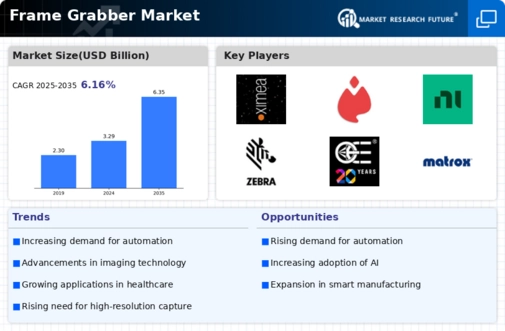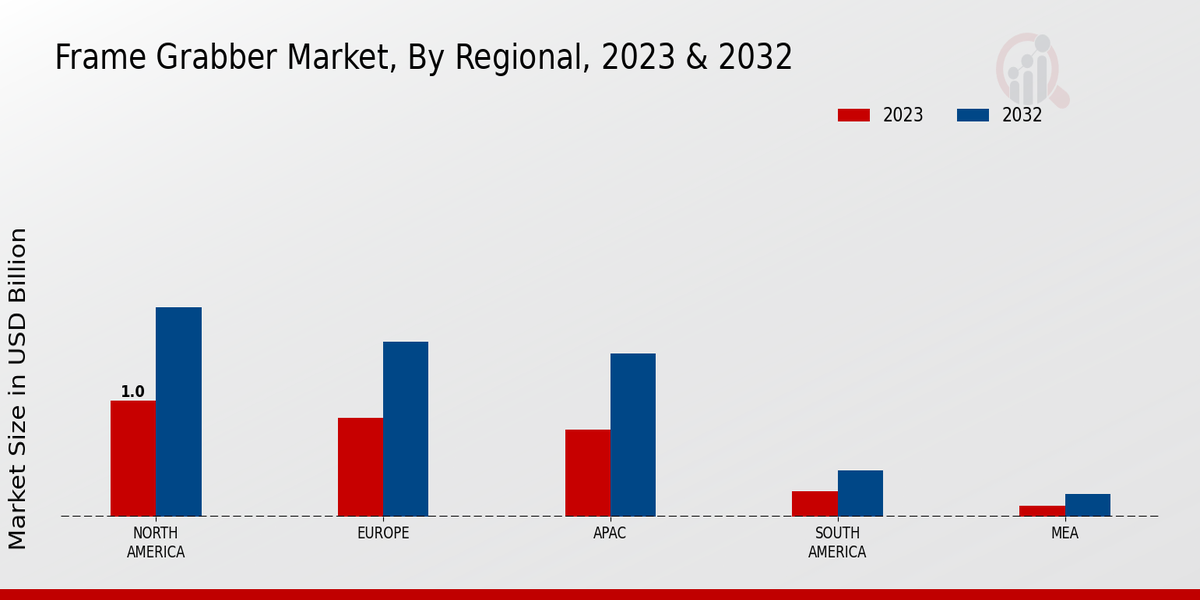Market Growth Projections
The Global Frame Grabber Market Industry is projected to experience substantial growth over the next decade. With a market value of 3.29 USD Billion in 2024, it is anticipated to reach 6.35 USD Billion by 2035. This growth trajectory indicates a compound annual growth rate (CAGR) of 6.16% from 2025 to 2035. The increasing adoption of advanced imaging technologies across various sectors, including industrial automation, healthcare, and security, is likely to drive this expansion. As industries continue to integrate sophisticated imaging solutions, the demand for frame grabbers will remain strong, reflecting their essential role in modern applications.
Increased Investment in R&D
The Global Frame Grabber Market Industry benefits from increased investments in research and development across various sectors. Companies are focusing on developing innovative imaging solutions that cater to specific industry needs, such as enhanced frame rates and improved data processing capabilities. This trend is particularly evident in sectors like automotive and aerospace, where high-performance imaging is critical for safety and efficiency. The commitment to R&D is likely to foster new product developments and technological breakthroughs, thereby driving market growth. As industries continue to prioritize innovation, the demand for advanced frame grabbers is expected to rise.
Expanding Applications in Healthcare
The Global Frame Grabber Market Industry sees substantial growth due to the expanding applications of imaging technologies in healthcare. Frame grabbers play a crucial role in medical imaging systems, enabling high-quality image capture for diagnostics and treatment planning. Technologies such as digital pathology and telemedicine are increasingly utilizing frame grabbers to enhance patient care and streamline workflows. The ongoing advancements in imaging modalities, coupled with the growing emphasis on precision medicine, suggest that the market will continue to thrive. The projected CAGR of 6.16% from 2025 to 2035 underscores the potential for growth in this sector.
Technological Advancements in Imaging
The Global Frame Grabber Market Industry experiences robust growth driven by continuous technological advancements in imaging technologies. Innovations such as high-resolution cameras and enhanced processing capabilities enable frame grabbers to capture and process images with unprecedented clarity and speed. For instance, the integration of AI and machine learning algorithms into imaging systems allows for real-time analysis and improved accuracy in various applications, including industrial automation and medical imaging. As a result, the market is projected to reach 3.29 USD Billion in 2024, reflecting the increasing demand for sophisticated imaging solutions across multiple sectors.
Rising Demand in Industrial Automation
The Global Frame Grabber Market Industry is significantly influenced by the rising demand for automation in various industrial sectors. Industries such as manufacturing, automotive, and pharmaceuticals increasingly rely on frame grabbers for quality control, process monitoring, and machine vision applications. The ability to enhance operational efficiency and reduce human error through automated systems is driving this trend. By 2035, the market is expected to grow to 6.35 USD Billion, indicating a strong shift towards automated solutions that leverage advanced imaging technologies. This growth is further supported by the increasing adoption of Industry 4.0 practices globally.
Growing Need for Real-Time Data Processing
The Global Frame Grabber Market Industry is propelled by the growing need for real-time data processing in various applications. Industries are increasingly relying on frame grabbers to capture and analyze images instantaneously, which is essential for applications such as surveillance, traffic monitoring, and quality assurance in manufacturing. The ability to process data in real-time enhances decision-making and operational efficiency, making frame grabbers indispensable in modern systems. As the demand for real-time analytics continues to rise, the market is poised for significant growth, reflecting the critical role of imaging technologies in contemporary applications.






















Leave a Comment